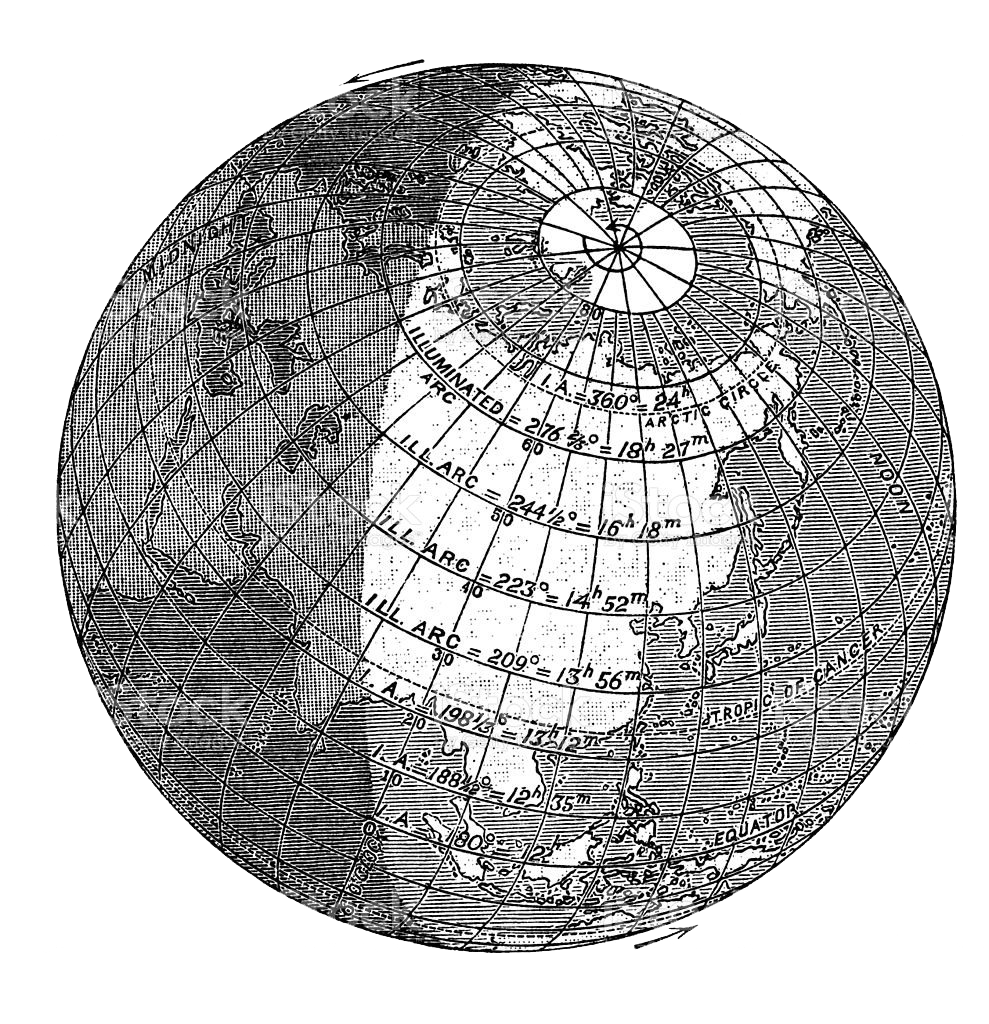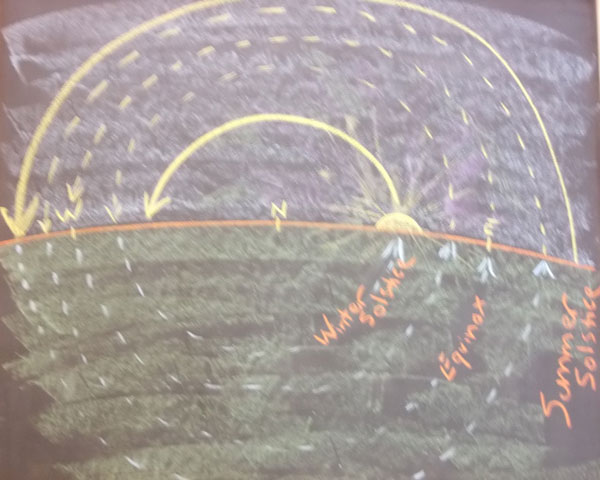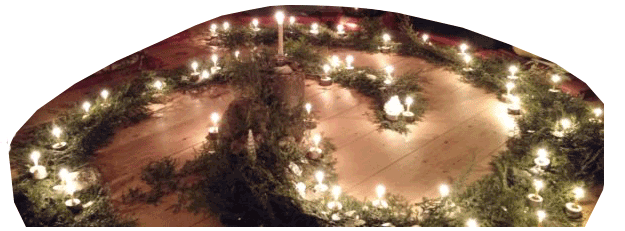|
|
|
The Solstice

Though I begin with an image of the Earth's orientation towards the Sun at its June Solstice, this is not, of course, what we observe, but rather a non-observable conceptual representation based on our understanding. A really good model of how our imagination construes reality from limited observations and our collective and community weavings of important narratives that helps us shape the world in which we live.
The model above shows clearly how we understand why we have the seasons, how our days fluctuate in daylight through the course of the year, and how and why the northern polar region have 24 hours of sunlight at this time, and conversely how the southern antartic region, closer to where I am, has continuous night-time at this time of the year. I say 'clearly', yet of course a little more weaving of our understanding of Solar system is in need to be a little more elaborated to grasp the fuller picture... something I am not going to do here at this time.
The Winter and Summer Solstices mark quite special times of the year. I the South (for those of us in the Southern parts of the world), the Sun rises somewhat tardily and prematurely beds. Ever since the lenghty days of Summer, days have steadily shortened, and, since the autumnal equinox, the hours of the night have exceeded daylight. The inverse os of course teur for those in the Norhern parts of the gloge at this time! Progressively, the weather has concomitantly reflected this darknening with crispness and cold - a cold that will now continue into the depths of Winter that follows the Solstice.
Seasons are understood in our broader community in varied and differing ways, and differently than through solely marking of daylight hours: for many, seasons are taken to better reflect the changes observed in the botanical or zöological worlds. For example, the birthing of lambs; or the nesting of birds; or the budding of trees; or the flowering of various shrubs. Indeed, in ancient Egypt, the flooding of the Nile, following the melting of the snow in the Ethiopian hills marked an important ‘seasonal’ change. We well know that in parts of northern Australia, six ‘seasons’ are similarly marked by a combination of growth and rain - and I personally well recall, living in norhtern Queensland in my youth, the coming of the tropical rains; the sudden appearance of the annual bloom of jellyfish; and the burning smoke from sugar-cane farms, each, in their own unique ways, marking annual progressive changes.
In the contemporary Australian calendar, essentially a Gregorian calendar, seasonal designations (Winter, etc) are marked as beginning on the first day of June, September, December and March. This is near unique and certainly different to most of the world, which instead marks the beginning of each season with the solstitial and equinoctial points within those same months (around the 21st of those months). Australian history provides part of the reason for this difference: stemming from colonial days when a British penal colony, British soldiers and penal officers posted in Sydney sweltered in heavy winter uniform in unaccustomed December heat (equivalent to wearing those heavy winter cloaks during June in San Fransisco or Athens). Pleading permission to switch to Summer-dress earlier than the designated 21st of December. the colony's Governor, undoubtedly similarly feeling overheated, relanted and allowed a Summer-dress start from the 1st of December. This has since determined the new seasonal marking, with ramifications for the other seasons through the course of the year, with Winter therefore determined as of the first of June, rather than by the Solstice.

Nonetheless, the Winter Solstice marks that very special time: the darkening days halt, and though the days will continue to mark with ever greater intensity the bitter cold, the crystalline quality of the Sun’s radiant light will begin to again expand in duration as daylight increases and nights begin to again shorten.
For those of us who rise early each morning to be bathed by the rising of the Sun, we observe that in Summer, the Sun rises further somewhat in a south-easterly point on the horizon. By the time of the equinox, the rising is directly eastward and its rising position on the horizon shifts markedly from day to day. And now, as we approach its northern most rising, nearly 60° from the Summer solstitial point, the point of rising appears to stand still from day to day, and doesn’t seem to rise quite as high in the sky at noon, only to set in late afternoon at nearly the same point from day to day and much further north than at its setting-point some six months prior. For those reading this in the Northern hemisphere, the inverse is of course the case... the point here could be made to take the time to observe, over the course of a year, the Sun's apparent daily motion from a relatively fixed point of observation.
If we were to daily represent the observed phenomena, connecting the night’s solar motion to reconnect its setting to its ensuing rising, the diurnal motion since January would look like an ever tightening spiral (there would of course be just over 160 of those spirals for half the year!):

This is precisely how many amongst us celebrate a Winter Solstice Spiral... slowly weaving in, and reminding ourselves that from this day forward, the days will begin to again lengthen as we turn again to expand the spiral. Another element of wonderful esoteric lore also allows for the Spiral to be depicted as a double spiral, reflecting the sigal of the tropical sign of Cancer, the latitude above which the Sun appears to remain 'still' over just under two weeks (reminding us of the 12 days of Christmas) - a perfect entry for us in the Southern parts to enter into the inward space of reflective work...
And hence the veracity of celebrations that make use of this inwarding spiral into which we call the light and rejoice at its returning expanding growth.

|